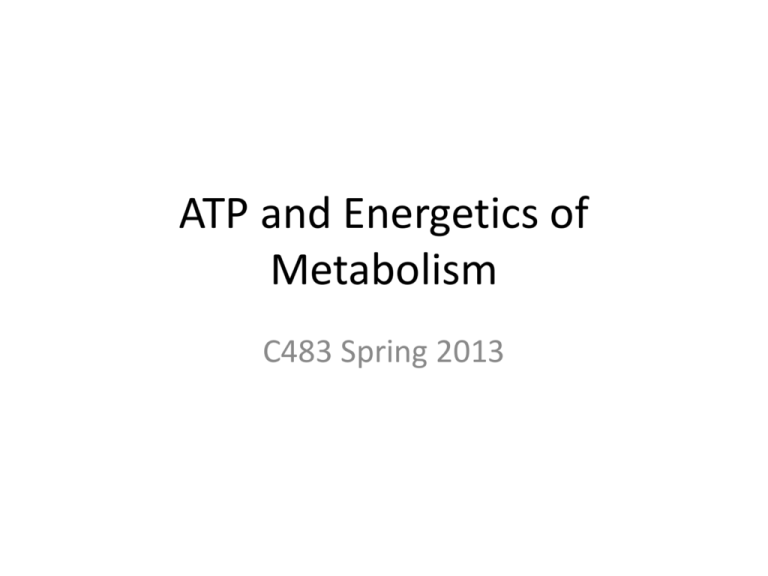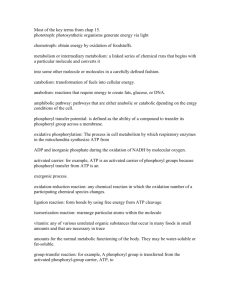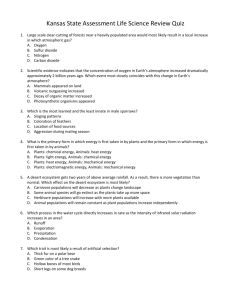ATP and Energetics of Metabolism
advertisement

ATP and Energetics of Metabolism C483 Spring 2013 1. What is false of a near-equilibrium reaction? A) Concentrations of reactants and products are near equilibrium concentrations. B) The enzyme reaction is most likely not regulated C) The standard free energy of the reaction is near zero. D) The free energy of the reaction is near zero. 2. Which thermodynamic quantity is used to determine if a reaction in a cell is spontaneous? A) △G°' B) △G C) △H D) △S 3. The hydrolysis of ATP to ADP has a △G°' of -30 kJ/mol. If in an E. coli cell the concentrations of ATP, ADP and inorganic phosphate are 7.90 mM, 1.04 mM and 7.9 mM, respectively, which statement is true about the hydrolysis of ATP in the cell? A) Hydrolysis cannot proceed spontaneously. B) The hydrolysis is at equilibrium. C) The free energy of the reaction is less negative than the standard free energy. D) The free energy of the reaction is more negative than the standard free energy. E. More than one of the above are true. 4. Which of the following is not a factor contributing to the large free energy of hydrolysis of ATP? A) Electrostatic repulsion of oxygen atoms. B) Better solvation of products than ATP itself. C) Complexes with Mg2+ or Mn2+ ions. D) Better stability of products than ATP itself. E) Electrical shielding of products of hydrolysis. 5. ATP is thermodynamically suited as a carrier of phosphoryl groups in animal cells because A) it is stable under cell conditions. B) it is not hydrolyzed in cells without enzyme action. C) it is intermediate in group-transfer potential. D) All of the above. Catabolism Anabolism ATP Hydrolysis • High energy bonds—inherent chemistry – Electrostatic repulsion – Solvation of products – Resonance • Rxn goes to “completion” Qualitative Predictions • Inherently favorable, unfavorable, or near equilibrium? Energetics: A metaphor Standard Free Energy vs. Free Energy DGo’ is negative DG is negative DGo’ is negative DG is zero Standard Free Energy vs. Free Energy ATP ATP AD ADP + P ADP P DGo’ is -32 kJ DG is -32 kJ DGo’ is -32 kJ DG is zero Quantitative • Inherent component • Concentration component Equilibrium • Equilibrium = DEAD! • What is [product]/[rxt] equilibrium of ATP hydrolysis to ADP? • [ADP][Pi]/[ATP] = 4.1 x 105 Free Energy of ATP hydrolysis • Actual cellular concentrations don’t vary much from [Pi]=[ATP] = 5 mmol and [ADP]= 1 mmol • What is the actual free energy of ATP hydrolysis in the cell? More or less than -32 kJ? Two Types of Reactions • Near-equilibrium reactions – [pdt] and [rxt] near equilibrium concentrations – DG close to zero (regardless of DGo’ ) – Not regulated—part of overall flux of metabolism • Metabolically irreversible reactions – DG far from zero – Can only be overcome by energy input – regulated ATP in Metabolism • Overcoming a barrier – Can’t change concentrations (ammonia is toxic!) – Couple the reaction to a spontaneous reaction! – Write an equation to couple to ATP hydrolysis: Mechanism of Coupling Phosphoryl Transfer in Energetic Intermediates Phosphoryl group transfer potential Answers 1. 2. 3. 4. 5. C B D C D





